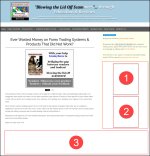- Home
- Forex Scalping
- scalping the markets
scalping the markets
(www.forextradingbonus.com)

Scalping NQ100 M1 time frame
The Forex market is the most volatile market in the world, having nearly US$5 trillion for its daily turnover; and it is active throughout the whole day. Considering the huge amount of volatility in the market, Forex traders are quicker than any other traders as regards the timing of their trades. Forex traders adhere to various trading strategies in order to achieve their desired benefits. Short-term traders generally follow Day Trading and Swing Trading Strategies , while the traders interested in longer term scenarios observe Positional Trading which involves a blend of fundamental and technical analyses. In the following article the most practiced strategy for short term trading, Scalping, would be explained in detail.
Scalping, as the name suggest, is a trading strategy that takes advantage of very small fluctuation within a trading pair, say around 10-20 pips. Scalpers take advantage of small changes within a pair over the large number of trading lots. They generally trade in the multiple lots and get the benefits of small changes within the pair value over the larger lot sizes. Scalpers are mainly interested in executing higher numbers of trades as they believe more trades would lessen their chances of incurring higher losses on a single trade, and increase their chances of making more profit. Another logical argument in favor of Scalping is that if we know the average movement of an underlying pair/security, it is better to part the whole move and trade on many movements rather than trade once and wait for the whole day. In case of economic events/news announcements, it is always advisable to go for small trading, and to leave the market before release in order to minimize the risk.
For example, if a scalper is trading EURUSD, then he/she would be interested in gaining not more than 10-20 pips in a single trade. If the traders gain $10 on every pip of a favorable move, he/she would be interested in gaining $100-200 on a single trade. However, it should be noted that their single trade doesn’t constitute one lot at a time. They put multiple lots in a single trade, near, let ’s say, 10 lots. Hence, he/she would be gaining nearly $1000-2000 for a single trade. Scalpers do very quick trading and the amount of trades are also huge. They may reach up to 100, or even more than that at the time of volatility in the market.
Every scalper should follow this set of basic rules: Choose pairs/securities which are highly volatile.
1.Target small profit.
2.Have strict entry/exit norms.
3.Trade in multiple lots.
4.Maximize the number of trades as and when the market gives an opportunity.
5.Never keep positions open for consecutive days—wind them up before day-end.
6.Never keep positions open for consecutive days—wind them up before day-end.
It should also be noted that scalpers are the keen observers of the market. They take note of each and every price move. They are quick in trading and are generally based on some authentic technical analysis. Hence, even though scalpers perform various trades, these are not based on their whims and fancies, and are logically connected to the analysis they have done.
Strategy
Now that we’ve understood what Scalping is, we will now move towards how one can enter into Scalping based on basic technical tools. In the following examples, we’ll take Bollinger Band and RSI as indicators to perform Scalping. The chart periodicity would be at 5 minutes, and the underlying is the Nasdaq-100 index.
The basic principle of Bollinger Band is whenever an underlying touches the upper band, it indicates the overbought situation and it is expected to correct towards the middle band or the lower band (if the move is too sharp). RSI, on the other hand, has a predefined rule of signaling above or near the 70 level as overbought, and below or near the 30 level as oversold. Hence, one should expect the correction as and when the RSI moves downwards from the 70 level. At the same time, he/she should expect recovery whenever the RSI moves upward from the 30 level. It should also be noted that the curve of the RSI also indicates a probable movement; a downward curve indicates correction, while an upward move indicates strengthening.
One should take a selling position whenever an underlying security/pair tests the upper band of the Bollinger and the RSI seems to be pointing downward from near/above the 70 level. He/she should maintain the target of the middle band with the stop-loss of the previous candle high/low, whichever is applicable. The same may be applied in case the underlying is moving near the lower band of the Bollinger and the RSI seems reversing from the 30 levels.
Example - see attached chart - above
As discussed earlier, Scalping is always performed with strict entry and exit rules in order to achieve small benefits based on technical indicators. In the above mentioned example of Nasdaq 100 index- 5 Minute chart, the scalper is observing two technical indicators, namely, the Bollinger Band and the RSI. He/she sells whenever the candle reverses back from testing the upper band of the Bollinger, which is then supported by the downtrending of the RSI, and vice versa. We can witness that the scalper has sold at 3058, and put the small stop-loss of 3060 for the target of 3055; hence, he/she has put the stop-loss of $2 in order to gain $3. After taking the said position, he/she exits within a time frame of 10 minutes with the desired profit. The Scalper again takes position of buying at 3052, as the candle reverses from the lower band of the Bollinger and the RSI also showing a rounding up from the level 30. And so, Scalpers keep on taking multiple positions within a short period of time, and reverse it as and when the predefined target or stop-loss gets triggered.
To sum up
Scalping, as the article explains it, is a short-term trading strategy with strict stop-loss and target limits. It is considered to be one of the most accepted for intraday traders, and has proven to be of great success. One should always consider the risk management tools and swiftness in trading while adhering to Scalping. It should also be considered that one should trade only those instruments which are highly liquid;
otherwise, there may be higher chances of making losses or of not being able to liquidate the positions in the desired time limit.
This article has been provided by www.forextradingbonus.com.





